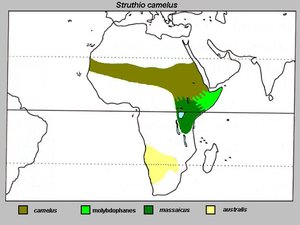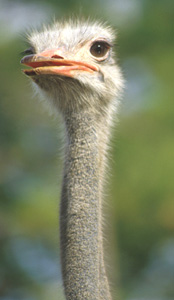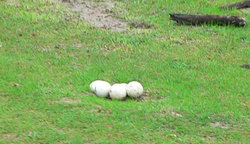Ostrich
|
|
| Ostrich | ||||||||||||||
|---|---|---|---|---|---|---|---|---|---|---|---|---|---|---|
 | ||||||||||||||
| Scientific classification | ||||||||||||||
| ||||||||||||||
| Binomial name | ||||||||||||||
| Struthio camelus Linnaeus, 1758 |
The Ostrich (Struthio camelus, Greek "sparrow camel") is the largest living bird, reaching a height of up to 2.5 metres (8 feet). It has a long neck and legs, is flightless, and is capable of running at about 65 km/h (40 mph). It lives in the wild in Africa, and is farmed all over the world.
| Contents |
Physical description
Male ostriches weigh up to 155 kg and are larger than females. The feathers of adult males are mostly black, with some white at the wings and tail. Females and young males are greyish-brown, with a bit of white.
The small vestigial wings are used by males in mating displays. They can also provide shadow to the chicks. The feathers are soft and quite different from the stiff airfoil feathers of flying birds. They serve as insulation. There are claws on two of the wings' fingers.
The strong legs don't have feathers. The bird stands on two toes, with the bigger one resembling a hoof. This is an adaption unique to ostriches which appears to aid in fast running.
The eyes of ostriches with their thick black lashes are the biggest eyes of all living land animals; only whales have bigger ones.
Classification and distribution
Ostriches belong to the ratites; other members of this group include rheas, emus, cassowaries and the largest bird ever, now extinct, Aepyornis. Ostriches are the only members of their family, Struthionidae.

Ostriches occur naturally on the savannas and semi-deserts of Africa, both north and south of the equatorial forest zone. Five subspecies can be distinguished:
- S. c. australis in South Africa
- S. c. camelus in Northern Africa
- S. c. massaicus in Eastern Africa
- S. c. molybdophanes in Ethiopia, Northern Kenya and Somalia
- S. c. syriacus in the Middle East, now extinct.(formerly very common in Arabia, Syria, Iraq, by the 20th century, it was considered extinct)
Behavior
Ostriches live in nomadic groups of 5–50 animals that often travel together with other grazing animals such as zebras or antelopes. They mainly feed on seeds and other plant matter; occasionally they also eat animal matter such as locusts. Lacking teeth, they swallow pebbles that help to grind the swallowed foods in the gizzard. They can go without water for a long time, exclusively living off the moisture in the ingested plants. However, they like water and frequently take baths.
With their acute eyesight and hearing, they can sense predators such as lions from far away.
In popular mythology, the ostrich is famous for hiding its head in the sand at the first sign of danger. The Roman writer, Pliny the Elder is noted for his descriptions of the ostrich in his historia naturalis, where he describes the ostrich and the fact that it hides its head in a bush. There have been no recorded observations of this behaviour. The myth may have resulted from the fact that, from a distance, when ostriches feed they appear to be burying their head in the sand because they deliberately swallow sand/pebbles to help grind up their food. When lying down and hiding from predators, the birds are known to lay their head and neck flat on the ground. When threatened, ostriches run away, but they can also seriously injure with kicks from their powerful legs.
Reproduction
Ostrich_egg.jpg
Straussenkueken.jpg
Ostriches become sexually mature when 2–4 years old. The mating process differs in different geographical regions. Territorial males will typically use hisses and other sounds to fight for a harem of 2–5 females. It will form a pair with one dominant female and breed with all of them. The female cowers on the ground and is mounted from behind by the male. The females will lay their fertilized eggs in a single communal nest, a simple pit scraped in the ground and about 30–60 cm deep. Ostrich eggs can weigh 1.3 kg and are the largest of all eggs, though they are actually the smallest relative to the size of the bird. The nest may contain 15–60 eggs. The eggs are incubated by the females by day and by the male by night, making use of the different colors of the two sexes to escape detection. The young hatch after some 35–45 days. Typically, the male will tend to the hatchlings.
Ostriches reach an age of about 30–40 years.
Ostriches and humans
MaleAndFemaleOstrichNewZealand_2004_SeanMcClean.jpg
In the past, ostriches were mostly hunted and farmed for their feathers, which used to be very popular as ornaments in ladies' hats and such. Their hides were also valued to make a fine leather. In the 18th century, they were almost hunted to extinction; farming for feathers began in the 19th century. The market for feathers collapsed after World War I. The ostriches in Arabia and Southwest Asia were hunted to extinction by the middle of the 20th century.
Today, ostriches are bred all over the world, including climates as cold as that of Sweden. Considering they will prosper in climates between 30? and -10? it is no wonder that they are farmed in over 50 countries around the world. Since they also have the best feed to weight ratio gain of any land animal(3,5:1 whereas that of cattle is 6:1) in the world, they are bound to appear attractive to farmers. Although they are farmed mostly for meat, additional useful byproducts are the eggs, offal, leather and feathers. It is claimed that ostriches produce the strongest commercially available leather1. Ostrich meat tastes similar to lean beef and compares favourably, being low in cholesterol.
Ostriches are large enough for a small human to ride them; typically, the human will hold on to the wings while riding. They have been trained in some areas of northern Africa and Arabia as racing mounts. Ostrich races in the United States have been criticized by animal rights organizations, however there is little possibility of this becoming a widespread practice due to the fact that the animals are difficult to saddle.
Ostriches are classified as dangerous animals in Australia, the US and the UK. There are a number of recorded incidents of people being attacked and killed. Big males can be very territorial and aggressive and can attack and kick very powerfully with their legs. An ostrich will easily outrun any athlete.
Also see
External link
- Photos of hatchlings and mating ostriches (http://www.geocities.com/ostrichwonderland/photos.htm)
Sources
- Ostrich farming facts in New Zealand (http://www.ostrich-association.co.nz/index.cfm/Facts) Note 1
- Honolulu Zoo page on Ostriches (http://www.honoluluzoo.org/ostrich.htm)
- Kruger Park page on Ostriches (http://www.krugerpark.co.za/africa_ostrich.html)


